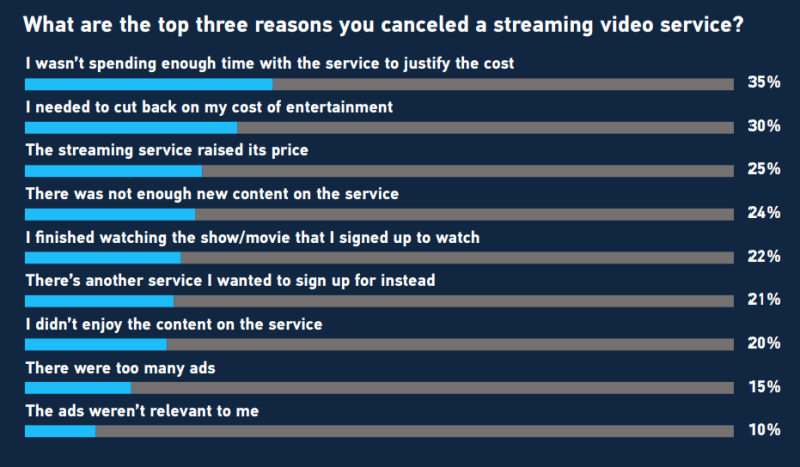A new survey from DirecTV found that one in five U.S. adults cancelled a streaming service in the past three months, as many don’t feel their usage justifies the cost.
According to the focus group survey, 22% dropped a streaming service, and the main reason cited for churning was not spending enough time on the platform to command the price. Asked to rank the top three reasons they dropped a service, other cost concerns came into play: 30% wanted to lower entertainment costs overall, while a quarter said the service had raised its price.
Beyond cost concerns, nearly a quarter said there wasn’t enough new content on the service or that they finished watching a show or movie that they had signed up to see in the first place.

“With consumers’ time splintered across streaming video, they are taking careful consideration of what services they choose to add, retain, or cancel,” concluded DirecTV.
DirecTV found consumers reported that they have access to at least one streaming video service via a promotional offer or free trial, and that deciding whether to stay or churn is highly dependent on the amount of time they spend.
The satellite TV provider, which commissioned the report based on virtual focus groups among U.S. adults conducted by consumer in-sights platform Suzy, pointed to virtual MVPDs as tending to have higher frequency of use than SVODs. DirecTV of course has its own virtual MVPD DirecTV Stream, which offers a cable-like lineup of live linear channels.
According to DirecTV, in May viewers 25-54 “spent twice as much time with DirecTV streaming services each week on average than they did with Netflix.”
For those that recently dropped a subscription, what would lure them back to resubscribe? Perhaps unsurprisingly, the answer is lower cost. For the top three reasons viewers would sign back up to a service they canceled, half said they would if the price dropped or a promotion was offered, followed by the addition of new programming (35%). And some continue to chase content and cycle, as just over a quarter said they would resign up for a new season of a show or sequel to a movie that the consumer initially had signed up to watch.
DirecTV’s survey comes as separate research from Hub Entertainment earlier this year also pointed to consumers hitting their limit on the number of streaming services they’re willing to shell out for. The May survey found that subscription stacking, or subscribing to multiple services, declined for the first time in five years, dropping to 6.4. The drop comes after a couple of years of strong growth for subscription stacking, with viewers doubling their amount of TV sources between 2019 and 2022 from 3.7 to 7.4.